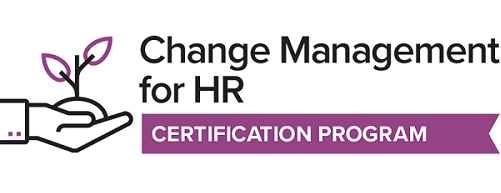Change Management for HR

Change Management for HR (CMHR) Certification
Why Should You Attend?
Ever been asked by your clients to help with change? Been part of an unsuccessful change initiative? Wondered why it’s so hard to communicate effectively about change? That’s because most change initiatives don’t take people and their needs into account.
HCI knows that the key to successful change is focusing on people over processes. This course will help you identify and build the capabilities people need to navigate change successfully. You’ll walk away with tools and an action plan for your next change initiative.
Image
Partner with the Business
Partner with the business to successfully manage change.
Image
Explore the Role of HR During Change
Distinguish among the three different roles that HR can play, and consider how to use each one.
Image
Create an Action Plan
Develop an action plan for your next change initiative that includes human-centered design, communication, and coaching.
Who Should Attend?
The Change Management for HR curriculum is designed for functional leaders, people leaders, and individual contributors seeking to advance their careers by elevating personal proficiencies, establishing HR as a partner to the business, and designing change initiatives that support engagement and organizational growth.
- HR Business Partner
- HR Generalist
- L&D Professional
Course Outline
|
Introduction
Introduction
- The role of change in organizations
- Change management principles
- Partnership between HR and the business
- HR’s change management roles: Architect, Broadcaster, Coach
The Architect
Designing Change Initiatives
- Overview of Architect role
- Using human-centered design for a change initiative
- Using nudges in change design
Partnering with the Business
- Obtaining buy-in and sponsorship
- Identifying and involving stakeholders
- Creating the change management team
- Establishing decision-making authority
Setting Up Change Initiatives for Success
- Assessing change readiness
- Identifying and addressing organizational barriers to change
- Planning for and evaluating sustainability
The Broadcaster
Communicating the Right Information in the Right Way
- Overview of Broadcaster role and why communication is important
- How to communicate:
- The change vision
- Reasons for the change
- Details about the change
- The impact on employees
- Progress of the change
- Framing each message
Building a Strategic Communication Plan
- Importance of being strategic and planful
- Audience considerations
- Timing of messages
- Communication channels/methods
- Choosing the right senders
- Emotional resonance
The Coach
Understanding and Addressing Reactions to Change
- Overview of the Coach role
- Different ways people react to change
- Addressing resistance and barriers
Maximizing Employees’ Capabilities
- Identifying training needs
- Creating a training plan
- Building confidence
- Developing a growth mindset
Keeping Employees Engaged Through Change
- Importance of keeping employees engaged
- Building team cohesion
- Encouraging resilience
- Reinforcement methods (rewards, recognition)
- Creating a network of coaches (managers, super users, ambassadors)
- Conclusion
- Action Planning



